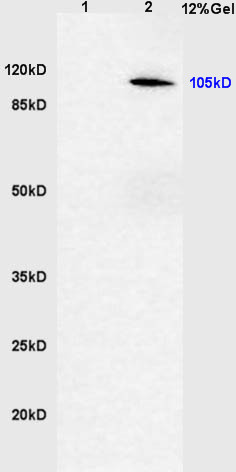
Rabbit Anti-phospho-CYLD (Ser418)antibody
CDMT; cylindromatosis (turban tumor syndrome); Deubiquitinating enzyme CYLD ; EAC; HSPC057; KIAA0849; turban tumor syndrome; Ubiquitin thiolesterase CYLD; Ubiquitin-specific processing protease CYLD; Cyld; CYLD_HUMAN; cylindromatosis 1; Ubiquitin-specific
View History [Clear]
Details
Product Name phospho-CYLD (Ser418) Chinese Name 磷酸化微管Binding proteinCYLD抗体 Alias CDMT; cylindromatosis (turban tumor syndrome); Deubiquitinating enzyme CYLD ; EAC; HSPC057; KIAA0849; turban tumor syndrome; Ubiquitin thiolesterase CYLD; Ubiquitin-specific processing protease CYLD; Cyld; CYLD_HUMAN; cylindromatosis 1; Ubiquitin-specific processing protease CYLD; Ubiquitin-specific-processing protease CYLD. Product Type Phosphorylated anti Research Area Tumour Immunogen Species Rabbit Clonality Polyclonal React Species Mouse, (predicted: Human, Rat, Dog, Pig, Cow, Horse, ) Applications WB=1:500-2000 ELISA=1:5000-10000
not yet tested in other applications.
optimal dilutions/concentrations should be determined by the end user.Theoretical molecular weight 105kDa Cellular localization cytoplasmic The cell membrane Form Liquid Concentration 1mg/ml immunogen KLH conjugated Synthesised phosphopeptide derived from human CYLD around the phosphorylation site of Ser418: FH(p-S)LP Lsotype IgG Purification affinity purified by Protein A Buffer Solution 0.01M TBS(pH7.4) with 1% BSA, 0.03% Proclin300 and 50% Glycerol. Storage Shipped at 4℃. Store at -20 °C for one year. Avoid repeated freeze/thaw cycles. Attention This product as supplied is intended for research use only, not for use in human, therapeutic or diagnostic applications. PubMed PubMed Product Detail Defects in CYLD are the cause of familial cylindromatosis (CYLD) also known as turban tumor syndrome or dermal eccrine cylindromatosis. CYLD is an autosomal dominant and highly tumor type-specific disorder. The tumors (known as cylindromas because of their characteristic microscopic architecture) are believed to arise from or recapitulate the appearance of the eccrine or apocrine cells of the skin that secrete sweat and scent respectively. Cylindromas arise predominantly in hairy parts of the body with approximately 90% on the head and neck. The development of a confluent mass which may ulcerate or become infected has led to the designation "turban tumor syndrome". The skin tumors show differentiation in the direction of hair structures, hence the synonym trichoepithelioma. CYLD has deubiquitinating activity.
Function:
Protease that specifically cleaves 'Lys-63'-linked polyubiquitin chains. Has endodeubiquitinase activity. Plays an important role in the regulation of pathways leading to NF-kappa-B activation. Contributes to the regulation of cell survival, proliferation and differentiation via its effects on NF-kappa-B activation. Negative regulator of Wnt signaling. Inhibits HDAC6 and thereby promotes acetylation of alpha-tubulin and stabilization of microtubules. Plays a role in the regulation of microtubule dynamics, and thereby contributes to the regulation of cell proliferation, cell polarization, cell migration, and angiogenesis. Required for normal cell cycle progress and normal cytokinesis. Inhibits nuclear translocation of NF-kappa-B. Plays a role in the regulation of inflammation and the innate immune response, via its effects on NF-kappa-B activation. Dispensable for the maturation of intrathymic natural killer cells, but required for the continued survival of immature natural killer cells. Negatively regulates TNFRSF11A signaling and osteoclastogenesis.
Subunit:
Interacts (via CAP-Gly domain) with IKBKG/NEMO (via proline-rich C-terminal region). Interacts with TRAF2 and TRIP. Interacts with PLK1, DVL1, DVL3, MAVS, TBK1, IKKE and DDX58. Interacts (via CAP-Gly domain) with microtubules. Interacts with HDAC6 and BCL3. Interacts with SQSTM1 and MAP3K7. Identified in a complex with TRAF6 and SQSTM1 (By similarity).
Subcellular Location:
Cytoplasm. Cytoplasm, perinuclear region. Cytoplasm, cytoskeleton. Cell membrane; Peripheral membrane protein; Cytoplasmic side. Note=Detected at the microtubule cytoskeleton during interphase. Detected at the midbody during telophase.
Tissue Specificity:
Detected in fetal brain, testis, and skeletal muscle, and at a lower level in adult brain, leukocytes, liver, heart, kidney, spleen, ovary and lung. Isoform 2 is found in all tissues except kidney.
Post-translational modifications:
Phosphorylated on several serine residues by IKKA and/or IKKB in response to immune stimuli. Phosphorylation requires IKBKG. Phosphorylation abolishes TRAF2 deubiquitination, interferes with the activation of Jun kinases, and strongly reduces CD40-dependent gene activation by NF-kappa-B.
DISEASE:
Defects in CYLD are the cause of familial cylindromatosis (FCYL) [MIM:132700]; also known as Ancell-Spiegler cylindromas or turban tumor syndrome or dermal eccrine cylindromatosis. CYLD is an autosomal dominant and highly tumor type-specific disorder. The tumors (known as cylindromas because of their characteristic microscopic architecture) are believed to arise from or recapitulate the appearance of the eccrine or apocrine cells of the skin that secrete sweat and scent respectively. Cylindromas arise predominantly in hairy parts of the body with approximately 90% on the head and neck. The development of a confluent mass which may ulcerate or become infected has led to the designation 'turban tumor syndrome'. The skin tumors show differentiation in the direction of hair structures, hence the synonym trichoepithelioma. Defects in CYLD are the cause of multiple familial trichoepithelioma type 1 (MFT1) [MIM:601606]; also known as epithelioma adenoides cysticum of Brooke (EAC) or hereditary multiple benign cystic epithelioma or Brooke-Fordyce trichoepitheliomas. MFT1 is an autosomal dominant dermatosis characterized by the presence of many skin tumors predominantly on the face. Since histologic examination shows dermal aggregates of basaloid cells with connection to or differentiation toward hair follicles, this disorder has been thought to represent a benign hamartoma of the pilosebaceous apparatus. Trichoepitheliomas can degenerate into basal cell carcinoma. Defects in CYLD are the cause of Brooke-Spiegler syndrome (BRSS) [MIM:605041]. BRSS is an autosomal dominant disorder characterized by the appearance of multiple skin appendage tumors such as cylindroma, trichoepithelioma, and spiradenoma. These tumors are typically located in the head and neck region, appear in early adulthood, and gradually increase in size and number throughout life.
Similarity:
Belongs to the peptidase C67 family.
Contains 3 CAP-Gly domains.
SWISS:
Q9NQC7
Gene ID:
1540
Database links:Entrez Gene: 1540 Human
Entrez Gene: 74256 Mouse
Omim: 605018 Human
SwissProt: Q9NQC7 Human
SwissProt: Q80TQ2 Mouse
Unigene: 578973 Human
Unigene: 482446 Mouse
Unigene: 128760 Rat
Unigene: 168938 Rat
CYLD(cylindromatosis)是近年发现的一种Tumour抑制基因,CYLD丢失或突变可致Tumour形成,多个研究显示,其表达蛋白CYLD可去Ubiquitin化TRAFs、NEMO、Bcl-3及p53等信号分子,调控细胞NF-κB和JNK等信号途径,CYLD在人体内广泛分布,在细胞周期的调控、介导Apoptosis、抑制Tumour发生等分子事件中有着重要的调控作用。
CYLD基因缺陷或缺失主要导致头部或面部的皮肤Tumour,如多发性家族性毛发上皮瘤(MFT),家族性圆柱瘤(FC)和Brooke-Spiegler综合症(BSS),此外,CYLD在宫颈癌、肾癌、结肠癌、肝癌形成的信号途径中也均表现为下游调控,是目前用于Tumour研究的热门抗体。
Product Picture
Bought notes(bought amounts latest0)
No one bought this product
User Comment(Total0User Comment Num)
- No comment



 +86 571 56623320
+86 571 56623320
 +86 18668110335
+86 18668110335

